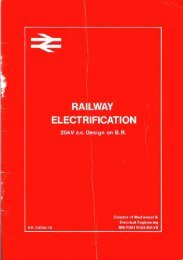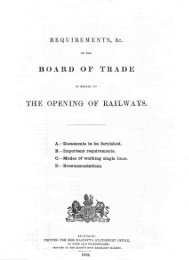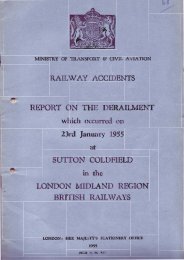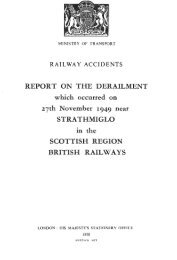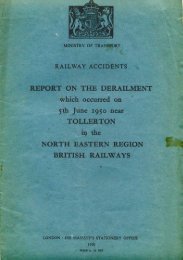R A I LT R AC K - The Railways Archive
R A I LT R AC K - The Railways Archive
R A I LT R AC K - The Railways Archive
Create successful ePaper yourself
Turn your PDF publications into a flip-book with our unique Google optimized e-Paper software.
Major stations<br />
Last year, we reported in very general terms on our work in<br />
preparing development control plans for each of our major<br />
stations.<strong>The</strong>se plans have now been progressed as part of<br />
our dialogue with customers and other stakeholders. A<br />
description of significant initiatives on a station-by-station<br />
basis is given in the relevant route section of this document.<br />
New stations<br />
We continue to evaluate the possibility of constructing new<br />
stations on the network,often in conjunction with funders.<br />
Since 1995, we have developed and opened 24 new stations.<br />
With the increase in rail passengers and the need to service<br />
growing communities,this trend is set to continue. Possible<br />
new stations include East Midlands Parkway, Edinburgh Park,<br />
Dysart (Fife),<strong>The</strong>ale (near Reading) and a number of<br />
parkway stations on the East Coast Main Line near<br />
Edinburgh,the M18 and M25 motorways.<br />
Depots<br />
We anticipated that 1998/99 would be a significant year in<br />
the future of development of light maintenance depots<br />
(LMDs),with our customers beginning to address their long-<br />
term needs in terms of both the location of and services<br />
provided at LMDs.<br />
This forecast has been confirmed over the past year<br />
and we have seen evidence of changes in approach adopted<br />
by train operators to deliver their train maintenance activity.<br />
Certain train operators are contracting out the role of<br />
depot facility owner, while others have established subsidiary<br />
companies for this purpose. Coupled with the investment in<br />
new trains and major advances in maintenance technology<br />
such as computerised diagnostics,train maintenance is an<br />
area of considerable change.<br />
Undoubtedly, major investment in maintenance, be it<br />
enhancing facilities or developing new depots,will be<br />
required.We are in detailed discussion with our industry<br />
partners to establish how our planned investment in LMDs<br />
can be best used to realise this objective.<br />
6.7<br />
6.7 Social and environmental benefits<br />
<strong>The</strong> benefits of upgrading the rail network are felt by<br />
many others as well as rail passengers and freight<br />
shippers.<strong>Railways</strong> have a significant contribution to make<br />
to achieve Government policy and commitments on<br />
protecting the environment.<br />
Increasing the capacity and efficiency of the rail network<br />
attracts passengers and freight currently using roads,and can<br />
therefore alleviate some of the impact of future growth on<br />
the road system.For those who live and work near roads,<br />
the benefits mainly accrue from reduced noise and air<br />
pollution,which affect health and the local environment.In<br />
addition, for those who switch from road to rail,the benefits<br />
include faster journey times as well as leading to a reduction<br />
in the cost of congestion and accidents.Consequently,<br />
society will benefit from our contribution towards reducing<br />
local pollution and mitigating climate change, since a rail<br />
transport solution offers savings in greenhouse gas emissions<br />
and noise relative to roads.All these factors are part of the<br />
cost–benefit equation for rail investment projects.<br />
We are using the results of rail transport and<br />
environment studies to assess the relief which investment<br />
projects will bring to the environmental and social costs of<br />
transport incurred by the public, or paid for out of the public<br />
purse.We recognise that this is a complex task because<br />
decisions to stimulate the use of rail travel cannot be made<br />
in isolation from other transport policy decisions (such as<br />
road pricing).It is important that methodologies are aligned<br />
with those used for Government decision-making.However,<br />
we have taken some early steps to assess the value of social<br />
benefits that could be gained through avoiding road journeys.<br />
Two schemes which are not viable on a commercial basis<br />
but which we have assessed are briefly described overleaf.<br />
Further information is available on Railtrack's website.We<br />
welcome debate and discussion on our approach.<br />
<strong>Railways</strong> have a<br />
significant contribution<br />
to make to achieve<br />
Government policy<br />
and commitments on<br />
protecting the<br />
environment<br />
71



